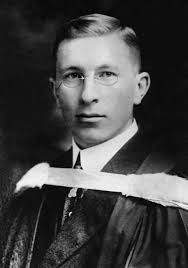Banting and Bethune: The Politics of Memory
- Elisabeth Edwards
- Oct 14, 2020
- 5 min read
Banting and Bethune, two great Canadian doctors who discovered life-saving innovations that changed the lives of countless people around the globe. Dr. Frederick Banting, the co-discoverer of insulin, is memorialized as a Canadian hero. His discovery continues an enduring legacy nearly one century later. Dr. Norman Bethune, another Canadian doctor who's humanitarian efforts brought forth the world's first mobile blood transfusion service, innovations in tuberculosis treatment and thoracic surgery, and universal healthcare.
Both doctors were born in small Ontario towns, graduated from the same University of Toronto Medical School class in 1916, both were talented visual artists, and both died at a young age of just 49 years old. However, I'd like to bet you've only heard one of these stories.
Left: Dr. Bethune's graduation portrait from UofT
Right: Dr. Banting's portrait from the same class
Dr. Banting, who conducted research for the British Armed Forces during WWII, is commemorated as a great Canadian. He is credited as the co-discovered of insulin, a discovery which made a healthy and thriving life possible for countless diabetics around the world. Banting, alongside other co-discoverers, was awarded the Nobel Prize in Medicine in 1923. His face adorned the cover of Time magazine that year, and his fame continued to rise around the world - quickly becoming one of the first truly famous Canadians.

Dr. Bethune, on the other-hand, is memorialized in a vastly contrasting way. Despite being born, educated, and having several successful careers in Canada, many Canadians never learned his story. Despite this, he is considered to be the most famous Canadian in the world as he is known to nearly 1 billion people in China and Spain. For the last two years of his life, Bethune travelled to China to serve alongside Chairman Mao's Eighth Route Army during the Second Sino-Japanese War. He travelled throughout the mountainous Yannan region of China, training thousands of doctors and nurses and creating innovative tools for field hospitals like an operating table that could be packed onto the back of a horse.
In October, 1939 Bethune cut his finger while operating on a wounded soldier. The wound soon became infected, and he died from septicaemia on November 12, 1939 at the age of 49. Chairman Mao wrote his eulogy titled In Memory of Norman Bethune, which was required to be read aloud and memorized in Chinese schools throughout the cultural revolution.

Left: Bethune operating on a wounded Chinese soldier in the mountains of Yennan.
The Chinese people remember him as "白求恩 / Bai Qiu En" which means "The Light Who Pursues Kindness". There Bethune are statues, hospitals, and monuments erected throughout China. You can even visit the peasant's hut where he died or his grave in Shijazhuang, China in the Cemetery of Martyrs.
In Canada, the only "monument" he is remembered at is Bethune Memorial House National Historic Site, which is owned and operated by Parks Canada. It protects and presents the small Victorian manse where he was born, and a museum with artifacts and interpretive exhibits dedicated to his life.

Left: a selfie with Dr. Bethune on Canada Day, 2017
I worked at this museum in Gravenhurst, Ontario for five years and it was such an interesting place to be introduced to Public History! Nearly 90% of the visitors (of which there are roughly 13,000 annually) speak Mandarin as a first language. Many of them travel from China just to visit the place where their hero was born, a sort of pilgrimage trip. I have given tours to elders who spoke next to no English, many of them stand next to the massive 20ft scroll of Mao's eulogy in Chinese characters in the Visitor's Centre and share the whole thing aloud from memory, some of them 50 or 60 years since they were taught it in school. The eulogy tells readers that Bethune embodies the ideal proletariat of the Communist movement.
Banting is remembered without the politics of geography or bureaucracy at play. Not only remembered by Canadians but by researchers, healthcare workers, and those with diabetes who are able to live healthy, thriving lives because of Banting's discovery. Bethune's legacy also continues to save lives, with his groundbreaking research in blood transfusion, and countless medical instruments he invented and improved which are still used in thoracic surgery today like the Bethune Rib Shears.
Below Left: Bethune Memorial House NHSC | Below Right: Banting House NHSC
Banting also shared socialist beliefs, however his legacy doesn't include this story. Following the development of Toronto Insulin, the first to be produced for general use, Banting sold the patent for just $1 claiming that no one should ever profit from the sale of insulin. Sadly, this is not the case for modern diabetics. Banting also travelled to Moscow, Russia for the 15th annual International Physiological Congress in 1935, where Bethune also attended. Banting met with Dr. Ivan Pavlov at the Pavlov Institute in Leningrad. The congress also placed emphasis on socialized healthcare and universal access to medical care around the world.

Left: Banting with Dr. Pavlov, 1935
Banting and Bethune were also both talented artists, painting and sketching offered an escape from the stress of working in war zones and long hours in labs. Banting planned on retiring at age 50 to focus on his art, but sadly he died at age 49 in a plane crash in Newfoundland.

Right: a painting bt Banting
Isn't it strange just how much these two Canadian doctors have in common? Yet the ways in which they are remembered in Canada are vastly different. The only explanation is the politics associated with them at the time of their deaths, where Banting was serving the British and
Bethune the Chinese.
Today, Bethune's legacy is beginning to be more pronounced in Canada with the growing population of Chinese citizens. Time has also healed misconceptions of his Communist beliefs as more politicians advocate for increased socialized healthcare benefits like the NDP's pharma-care plan.
Above Left: Life sized statue of Dr. Banting outside Banting House
Above Right: Life sized statue of Dr. Bethune outside the Bethune Memorial House Visitor's Centre
I believe this story is one of many which should prompt historians to consider the current political climate rather than seeing the past as objective and unchanging. We are seeing increased awareness of this with the toppling of statues which commemorate the violence of colonialism and the erasure of Indigenous peoples and cultures. Our memory is in flux with the past and the future, collapsing onto each other to inform the present. Whenever you are confronted with an uncomfortable feeling or belief relating to a person or a history, I urge you to sit with those feelings and continue to unravel what ideologies have shaped that belief. Then topple them.
Check out Banting House's website here: http://bantinghousenhsc.wordpress.com/
and Bethune Memorial House's website here: https://www.pc.gc.ca/en/lhn-nhs/on/bethune























Fascinating discussion on how history shapes collective memory! On a different note, for those in Surrey looking to advance their careers in logistics and warehousing, Clamp Forklift Operators jobs in Surrey offer great opportunities for skill development and stable employment.